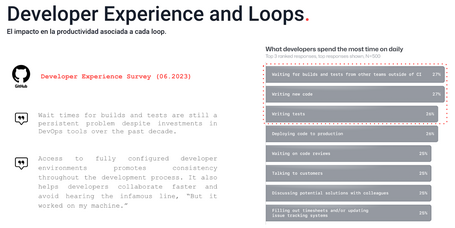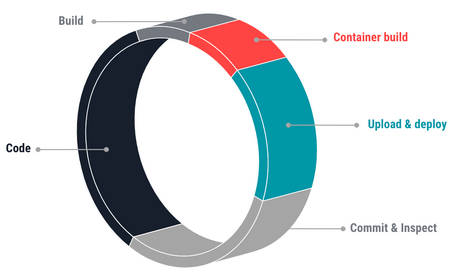The product mindset in Platform Engineering emphasizes continuous improvement, where regular feedback and performance metrics are key to refining the platform. Evaluating the effectiveness of Platform Engineering initiatives is crucial to ensuring they deliver the intended benefits and evolve in alignment with organizational goals.
The best approach is to identify what success looks like in your organization. Is it improved developer satisfaction? More releases per quarter? It is essential to look at your internal platform as a product: what does the success of that product look like?
Success is measured through a combination of quantitative metrics and qualitative feedback from internal users, making it essential to design a strategy that includes key metrics such as time-to-market, developer satisfaction, platform adoption rates, and error reduction.
A Platform Engineering strategy, therefore, requires a comprehensive framework to measure, evaluate, and steer the initiative.
Building Your Framework Around Mission-Driven Metrics
Since the release of Accelerate: The Science of Lean Software and DevOps, the focus has been on improving team performance through value delivery. Key metrics like Lead Time, Deployment Frequency, MTTR, and Change Failure Rate are essential for assessing and enhancing organizational performance. Alongside these, capabilities such as Continuous Delivery, supportive architecture, Lean management, and a culture of collaboration are crucial.
DORA (DevOps Research and Assessment) embodies these principles and offers a refined starting point for developing a framework to evaluate Platform Engineering success, aligning it with organizational performance:
- Deployment Frequency – How often an organization successfully releases to production.
- Lead Time for Changes (Cycle Time) – The amount of time it takes a commit to get into production.
- Change Failure Rate – The percentage of deployments causing a failure in production.
- Mean Time to Recovery (MTTR) – How long it takes an organization to recover from a failure in production.
This framework connects these capabilities and metrics to broader organizational outcomes, demonstrating that high-performing teams can deliver software faster, more reliably, and with better quality, leading to improved business outcomes such as profitability, productivity, and market share.

However, success in Platform Engineering isn’t just about hitting metrics; it’s also about ongoing refinement and evolution. To ensure the platform remains relevant and effective, your framework must consider standard product management practices to capture user feedback (surveys, feedback forms, and direct communication). This practice allows platform engineers to understand the pain points and needs of developers, guiding platform improvements.
- Developer Satisfaction:
- What It Measures: How satisfied developers are with the platform, its tools, and processes.
- Why It Matters: A high level of developer satisfaction indicates that the platform is effectively reducing cognitive load, improving productivity, and meeting the needs of its users. Regular surveys and feedback loops can help measure this metric.
- Platform Adoption Rates:
- What It Measures: The percentage of development teams actively using the platform.
- Why It Matters: High adoption rates suggest that the platform is valuable and well-integrated into the development workflow. Monitoring adoption can help identify areas where further training or platform improvements are needed.
Lead Time for Changes: A Comprehensive Metric for assessing the Developer Experience
Lead Time for Changes is one of the most comprehensive metrics for evaluating the success of Platform Engineering. This metric is critical because it encapsulates the entire development process, highlighting how quickly and reliably new features or fixes can move from ideation to production. By shortening this lead time, organizations can respond faster to market demands, reduce time-to-market, and gain a competitive edge.
Focusing on Lead Time for Changes allows Platform Engineering to address not only the technical aspects of the development lifecycle but also to enhance the overall developer experience. From the moment a developer writes code to the time it’s live in production, Platform Engineering provides the tools, automation, and standardization needed to streamline the process, reduce friction, and improve efficiency.
According to the Developer Experience Survey conducted by GitHub in 2023, inefficiencies in the inner loop were identified as the top time-consuming task for developers.

The Inner Loop encompasses everything required to develop a feature within a development environment—essentially, everything that happens before the code is pushed to an integrated branch. Once the code is pushed, continuous integration is triggered, and the outer loop takes control.

Therefore, any improvement to the inner or outer loop directly impacts the Lead Time for Changes metric. By optimizing these loops, Platform Engineering ensures that development processes are more efficient, reducing the time it takes for code to move from conception to deployment.
How Platform Engineering Enhances Lead Time for Changes
Platform Engineering plays a pivotal role in reducing Lead Time for Changes by optimizing and enabling various stages of the development lifecycle. For example:
- Automated provisioning of Development Environments
- Challenge: One of the initial hurdles in the development process is setting up consistent and reliable development environments. Developers often face the "it works on my computer" problem, where code functions correctly on a local machine but fails in other environments due to discrepancies in configurations, dependencies, or tools.
- How Platform Engineering Helps: Platform Engineering automates the creation of development environments that are consistent, reproducible, and fully integrated with the platform's capabilities. By using Infrastructure as Code (IaC) and containerization, the platform ensures that every developer has access to an environment that mirrors production settings. This reduces setup time, minimizes errors related to environment inconsistencies, and allows developers to focus on writing code rather than troubleshooting configurations.
- Reducing the Inner Loop
- Challenge: The "inner loop" refers to the cycle of coding, building, and testing that developers go through multiple times a day. A slow inner loop can significantly increase the lead time, as developers spend more time waiting for feedback from their changes.
- How Platform Engineering Helps: By providing streamlined and automated feedback mechanisms, Platform Engineering accelerates the inner loop. Integrated testing tools, fast builds, and instant feedback systems ensure that developers can quickly see the impact of their changes. This reduces the time spent in the inner loop, allowing developers to iterate faster and push changes to the next stage more quickly.
- Standardizing the Outer Loop (CI)
- Challenge: The "outer loop" involves the processes that occur after the code leaves the developer’s hands, such as continuous integration (CI), testing, and deployment. Inconsistent or inefficient CI processes can create bottlenecks, slowing down the progression from code commit to production.
- How Platform Engineering Helps: Platform Engineering standardizes and automates the CI process, ensuring that all code passes through a consistent pipeline. This includes automated testing, security scans, and deployment processes that are pre-configured to meet organizational standards. By eliminating manual steps and standardizing the outer loop, Platform Engineering reduces delays and errors, leading to a more predictable and faster path to production.
- Streamlining Deployment and Release Management
- Challenge: The final stage in the development lifecycle—deployment to production—can often be fraught with challenges, especially in complex environments where manual interventions are required.
- How Platform Engineering Helps: Platform Engineering simplifies deployment through automated release management tools and self-service capabilities. Developers can deploy their code with confidence, knowing that the platform handles rollbacks, monitoring, and compliance checks. This reduces the lead time by ensuring that deployments are smooth, predictable, and repeatable.
How Can We Measure and Improve Platform Engineering Maturity?
As organizations increasingly adopt Platform Engineering practices, it's crucial to have a framework that helps assess and guide their progress. Recognizing this need, the Cloud Native Computing Foundation (CNCF) released the Platform Engineering Maturity Model to provide a structured approach to evaluating the maturity of platform engineering within an organization.
Why the CNCF Released the Maturity Model
The CNCF's Platform Engineering Maturity Model was developed to address the growing complexity of software delivery processes and the need for organizations to measure and improve their platform engineering capabilities systematically. As platform engineering becomes more integral to achieving business agility and operational efficiency, organizations require a clear roadmap to understand where they stand and how they can advance.
The maturity model serves several key purposes:
- Benchmarking Progress: It provides a way for organizations to benchmark their current platform engineering practices against industry standards, helping them identify strengths and areas for improvement.
- Guiding Development: By offering a structured progression, the model helps organizations prioritize their efforts and investments, ensuring that they focus on the most impactful areas of platform engineering.
- Facilitating Communication: The maturity model creates a common language for discussing platform engineering initiatives, enabling clearer communication between technical teams and business stakeholders.
Martin Fowler says it well: “The true outcome of a maturity model assessment isn’t what level you are at but the list of things you need to work on to improve. Your current level is merely a piece of intermediate work in order to determine that list of skills to acquire next.”
Overview of the CNCF Platform Engineering Maturity Model
The CNCF’s Platform Engineering Maturity Model outlines a series of stages that organizations typically progress through as they develop and refine their platform engineering practices. Each stage represents a higher level of maturity, characterized by more advanced capabilities, improved processes, and greater alignment with organizational goals.
This maturity model provides a clear path for organizations to follow, helping them to understand their current state and identify the steps needed to reach higher levels of platform maturity. By progressing through these stages, organizations can ensure that their platform engineering efforts are aligned with business objectives and are delivering maximum value.
The model typically includes the following stages:
- Initial (Ad Hoc):
- Platform efforts are informal and unstructured.
- There is little to no standardization, and teams often work in silos.
- Repeatable:
- Basic platform capabilities are in place, but practices are inconsistent.
- Some processes are repeatable, but there is still significant variability.
- Defined:
- Platform capabilities are well-defined, documented, and standardized across the organization.
- Teams begin to collaborate more effectively, and best practices are established.
- Managed:
- The platform is actively managed, with performance metrics and feedback loops in place.
- Continuous improvement is embraced, and the platform evolves based on user needs and organizational goals.
- Optimized:
- The platform is fully integrated into the organization’s operations, driving significant improvements in efficiency, scalability, and innovation.
- Advanced automation, security, and governance are embedded into the platform, making it a critical asset for the organization.
If you’re interested in diving deeper into Platform Engineering, you can check out the rest of the posts in this series below, where we explore many aspects of Platform Engineering in detail:
- What Platform Engineering is (and what it isn’t)
- Core Elements of Platform Engineering
- Key Benefits of Platform Engineering
- Barriers to Adoption of Platform Engineering
- How to Release a Platform as a Product?
- Understanding Golden Paths: A Practical Guide
We hope you find it useful. Let us know your thoughts in the comments! 👇
Comments are moderated and will only be visible if they add to the discussion in a constructive way. If you disagree with a point, please, be polite.









Tell us what you think.